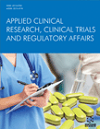- Home
- A-Z Publications
- Applied Clinical Research, Clinical Trials and Regulatory Affairs
- Previous Issues
- Volume 6, Issue 2, 2019
Applied Clinical Research, Clinical Trials and Regulatory Affairs - Volume 6, Issue 2, 2019
Volume 6, Issue 2, 2019
-
-
Critical Review on Food Safety Standard Regulations: A Real Scrutinizing Authority or a Misleading Player for Probiotic Products
More LessAuthors: Malika Arora, Navdeep Kaur, Manish Arora and Parveen BansalBackground: Probiotics is a broad term used for friendly bacteria which are increasingly used in present scenario due to their wide range of health benefits accompanied by low cost and negligible side effects. The status of the probiotics as a component of food is not clear in the health industry. The use of probiotic bacteria is exploited over-the-counter as dietary supplements or in food products such as yogurt, as well as in the p Read More
-
-
-
Safety of Pharmaceutical Excipients and Regulatory Issues
More LessAuthors: Kanteti V.R.N.S. Ramesh, Hemant Yadav and Omar SarheedBackground: Pharmaceutical excipients are critical in the formulation of any dosage form. Not many additives employed in the drug product manufacture have properties, which meet the desired qualities that the finished product must have. Therefore, it is mandatory to mix the drug substance with other substances to overcome the deficiencies. As a result, almost all pharmaceutical products are mixtures of active ph Read More
-
-
-
Implementation of Quality by Design: A Review
More LessAuthors: Deepika Purohit, Manisha Saini, Parijat Pandey, Swagat Tripathy and Harish DurejaBackground: In pharmaceutical terms, quality means a product free from any contamination and delivers the therapeutic benefit specified in the label at a reproducible rate which can be assessed by carrying out in vivo or in vitro tests for evaluation of performance. Quality by Design (QbD) is a necessary tool in pharmaceutical environment for having product/process/method impregnated with quality. QbD is a move toward dr Read More
-
-
-
Hyaluronic Acid: The Reason for Its Variety of Physiological and Biochemical Functional Properties
More LessAuthors: Rami Al-Khateeb and Jelena PrpicIntroduction: Many physicians may be unfamiliar with the importance of hyaluronic acid (HA) and its physiological and biochemical functions at cellular level. Despite the vast number of published studies using HA in medical treatments, it is still difficult for the reader to clearly distinguish the different types of HA employed in different medical applications. In addition, published studies do not mention the exact type of HA used Read More
-
Most Read This Month
Article
content/journals/acctra
Journal
10
5
false
en

Most Cited Most Cited RSS feed
-
-
-
A Rapid LC-ESI-MS/MS Method for the Quantitation of Salicylic Acid, an Active Metabolite of Acetylsalicylic Acid: Application to in vivo Pharmacokinetic and Bioequivalence Study in Indian Healthy Male Volunteers
Authors: Dhiman Halder, Shubhasis Dan, Easha Biswas, Pradipta Sarkar, Umesh C. Halder and Tapan K. Pal
-
- More Less

